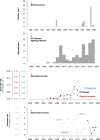Fin whales of the Great Bear Rainforest: Balaenoptera physalus velifera in a Canadian Pacific fjord system
- PMID: 34478477
- PMCID: PMC8415578
- DOI: 10.1371/journal.pone.0256815
Fin whales of the Great Bear Rainforest: Balaenoptera physalus velifera in a Canadian Pacific fjord system
Erratum in
-
Correction: Fin whales of the Great Bear Rainforest: Balaenoptera physalus velifera in a Canadian Pacific fjord system.PLoS One. 2024 Jun 21;19(6):e0305297. doi: 10.1371/journal.pone.0305297. eCollection 2024. PLoS One. 2024. PMID: 38905192 Free PMC article.
Abstract
Fin whales (Balaenoptera physalus) are widely considered an offshore and oceanic species, but certain populations also use coastal areas and semi-enclosed seas. Based upon fifteen years of study, we report that Canadian Pacific fin whales (B. p. velifera) have returned to the Kitimat Fjord System (KFS) in the Great Bear Rainforest, and have established a seasonally resident population in its intracoastal waters. This is the only fjord system along this coast or elsewhere in which fin whales are known to occur regularly with strong site fidelity. The KFS was also the only Canadian Pacific fjord system in which fin whales were commonly found and killed during commercial whaling, pointing to its long-term importance. Traditional knowledge, whaling records, and citizen science databases suggest that fin whales were extirpated from this area prior to their return in 2005-2006. Visual surveys and mark-recapture analysis documented their repopulation of the area, with 100-120 whales using the fjord system in recent years, as well as the establishment of a seasonally resident population with annual return rates higher than 70%. Line transect surveys identified the central and outer channels of the KFS as the primary fin whale habitat, with the greatest densities occurring in Squally Channel and Caamaño Sound. Fin whales were observed in the KFS in most months of the year. Vessel- and shore-based surveys (27,311 km and 6,572 hours of effort, respectively) indicated regular fin whale presence (2,542 detections), including mother-calf pairs, from June to October and peak abundance in late August-early September. Seasonal patterns were variable year-to-year, and several lines of evidence indicated that fin whales arrived and departed from the KFS repeatedly throughout the summer and fall. Additionally, we report on the population's social network and morphometrics. These findings offer insights into the dynamics of population recovery in an area where several marine shipping projects are proposed. The fin whales of the Great Bear Rainforest represent a rare exception to general patterns in this species' natural history, and we highlight the importance of their conservation.
Conflict of interest statement
One of our authors (BH) is affiliated with SoundSpace Analytics, a commercial bioacoustics consultancy. This affiliation does not alter our adherence to PLOS ONE policies on sharing data and materials.
Figures








References
-
- Edwards EF, Hall C, Moore TJ, Sheredy C, Redfern JV. Global distribution of fin whales Balaenoptera physalus in the post-whaling era (1980–2012). Mammal Rev. 2015;45: 197–214. 10.1111/mam.12048 - DOI
-
- Cooke J. The IUCN Red List of Threatened Species. In: IUCN Red List of Threatened Species [Internet]. [cited 5 Jun 2021]. Available: https://www.iucnredlist.org/en
-
- Canada, Environment and Climate Change Canada, Committee on the Status of Endangered Wildlife in Canada. COSEWIC assessment and status report on the Fin Whale, Balaenoptera physalus, Atlantic population, Pacific population, in Canada. 2019. Available: https://epe.lac-bac.gc.ca/100/201/301/weekly_acquisitions_list-ef/2020/2...
-
- Fisheries N. Fin Whale 5-Year Review | NOAA Fisheries. In: NOAA [Internet]. 27 Jan 2021 [cited 5 Jun 2021]. Available: https://www.fisheries.noaa.gov/resource/document/fin-whale-5-year-review
-
- Archer EA. Revision of fin whale Balaenoptera physalus (Linnaeus, 1758) subspecies using genetics | Journal of Mammalogy | Oxford Academic. 2019. [cited 5 Jun 2021]. Available: https://academic.oup.com/jmammal/article/100/5/1653/5552346?login=true
Publication types
MeSH terms
LinkOut - more resources
Full Text Sources

